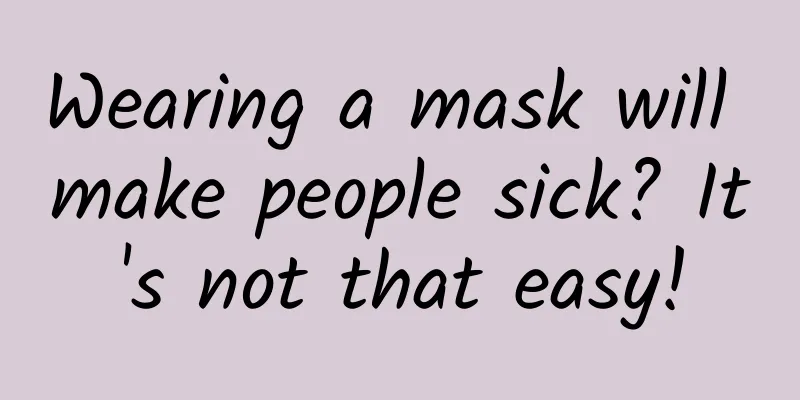Wearing a mask will make people sick? It's not that easy!

|
The COVID-19 pandemic has repeatedly recurred, and masks have become a daily standard for everyone. There have been many rumors about masks, some of which are very outrageous. For example, someone forwarded a message in a WeChat group, saying that wearing a mask may cause hypoxia and cause various health problems. At first glance, this rumor seems to be well-founded and serious, but it can be described in just four words: What nonsense. In fact, such rumors were spread in 2021, and many well-known foreign media also interviewed experts in related fields to refute the rumors at the time. The short video of Margarite Griesz-Brisson mentioned in the article was also removed from Youtube for violating community regulations, which shows that it is unreliable. Tuchong Creative However, in order to better explain whether masks have any impact on health, it is still necessary to talk about the principles behind it. Let's talk about it in detail. 01 Do masks really affect breathing? Wearing a mask does make people feel a little uncomfortable or even a little uncomfortable, but does this really mean that normal breathing will be affected, leading to a decrease in blood oxygen and hypercapnia as the rumors say? Let's look at a little experiment first. The University of California, San Diego Health Office once filmed an experimental video to see if masks can affect breathing, and the results were simply shocking. The experimenter first measured the blood oxygen saturation, which was 98% - a low indicator means hypoxia. Then she wore 4 layers of masks at a time and measured the blood oxygen saturation again, and found that it was still 98%. After adding 3 layers of masks, the blood oxygen saturation only dropped to 97%. From the experimental video, note that the blood oxygen number is 98 in the upper picture and 97 in the lower picture. So what does this mean? Could changes of this magnitude affect our breathing? The conclusion is no. In fact, blood oxygen concentration is normal between 95% and 100%, and the body may not react to this slight change. There is no problem with oxygen, but what about carbon dioxide? In the same experimental video, another subject first tested the partial pressure of carbon dioxide in the body, and the value was 31.6mmHg. After wearing 4 layers of masks, the value became 31.8mmHg. After adding 3 more layers of masks, it only rose by 0.7mmHg to 32.5mmHg. An experiment to measure the partial pressure of carbon dioxide in the body. For ordinary people, the normal range of carbon dioxide partial pressure is 30mmHg-45mmHg, so the impact of masks is minimal. As for some people who insist that masks make it difficult for carbon dioxide to be discharged, causing people to inhale and cause poisoning, this is also unreliable. On the one hand, it is dangerous to breathe in carbon dioxide at a concentration of up to 10%, while the concentration of carbon dioxide in our daily air is only 0.04%. Even the waste gas we exhale has a carbon dioxide concentration of only 4-5%. Putting your head into a plastic bag and tying it tightly may cause the problem of excessive carbon dioxide concentration. The medical masks that ordinary people wear on a daily basis are breathable. Although they need to breathe a little harder than usual, it is not difficult to inhale enough oxygen and expel carbon dioxide properly. 02 Different people wear different masks, and the effects are different After reading the previous article, we should have known that wearing ordinary medical masks does not affect our oxygen supply. In this way, all the rumors that masks cause hypoxia and high carbon dioxide concentrations cause diseases will naturally be refuted. However, the previous article talked about healthy people wearing ordinary medical masks. There are still some special situations that need to be paid attention to. Let's talk about them briefly below. For the masks we wear daily, ordinary medical masks are preferred. Masks like N95 or masks with higher filtration performance are more suitable for professionals in high-risk environments. Ordinary people are prone to discomfort when wearing N95 masks for a long time. In addition, people who are prone to breathing difficulties, such as smokers, emphysema patients, and obese people, will feel even worse and even aggravate their breathing problems if they wear N95 masks. Tuchong Creative In addition, for patients with certain lung diseases such as pulmonary fibrosis, wearing a mask may indeed affect blood oxygen. However, such patients are more likely to develop critical symptoms if infected with the new coronavirus. Therefore, if you need to be in a closed public place, wearing a mask for a short period of time is more beneficial than harmful. There is another question that has troubled many friends, that is, can you wear a mask when exercising? Surprisingly, a study has shown that, at least for healthy young people (the age of the participants was 28.2±8.7 years old), there is no need to worry about hypoxia even if you exercise with a medical mask, but you may be a little uncomfortable. As for wearing it normally, there is no problem. Of course, the study is listed here only to show that wearing a mask is not dangerous, not to recommend that you wear a mask when exercising. 03 There are still these misunderstandings about masks Now that we know that masks do not affect our normal breathing, let’s review other misunderstandings about masks. This will help you use masks better and prevent the new coronavirus. I don’t feel any difficulty breathing when I wear a mask? If you feel this way, you may not be wearing the mask correctly. If you still feel that you can breathe smoothly after wearing the mask, you should check whether the metal nose clip on the bridge of your nose has been pressed to fit the bridge of your nose and whether there is air leakage at the chin. If the mask is worn correctly, you should feel a little bit of obstruction when breathing. If your glasses fog up when you wear a mask in winter, it also means that the bridge of your nose is probably not adjusted properly. Don't choose models with breathing valves, as this will increase the risk | Tuchong Creative Masks and cotton swabs contain graphene. Will it be harmful to health? The so-called "graphene masks" currently sold on the market are mostly gimmicks. For example, a certain "biomass graphene" raw material was found to be processed from straw. It is worth noting that some mask materials use nano-grade activated carbon, and long-term wearing of activated carbon masks does pose a risk of inhaling particles. For daily epidemic prevention, the public should choose protective masks that meet national standards. As for cotton swabs, adding graphene or activated carbon is nonsense. The higher the protection level of the mask, the better? Not necessarily. As mentioned earlier, ordinary people do not necessarily have to wear N95 or above masks in their daily lives. This is because masks with high protection levels often have a greater impact on breathing, and wearing them for a long time can easily cause discomfort. For the sensitive people mentioned above, it is more likely to bring health risks. This is fine | Tuchong Creative In fact, for ordinary people, we only need to identify the implementation standards of masks for daily use. For example, the corresponding standard for medical surgical masks is YY0469-2011; the corresponding standard for disposable medical masks is YY/T0969-2013, and the corresponding standard for disposable protective masks is GB/T 32610-2016, which is the "national standard". In addition, masks for children should meet the requirements of GB/T 38880-2020. In addition, when choosing N95, KN95 and above masks, be careful to avoid models with breathing valves. Do you have to shake the mask before wearing it, otherwise the residue on the mask will cause cancer? Qualified medical masks do not have this risk. Masks can absorb the ethylene oxide used for disinfection. Although ethylene oxide is a class I carcinogen, the toxicity also depends on the dosage. According to national standards, the residual ethylene oxide content of the mask does not exceed 10μg/g, which is safe. After the manufacturer uses ethylene oxide to sterilize the mask, it will not be shipped until the residual amount is qualified. In addition, the residual ethylene oxide will naturally evaporate during the circulation process. Therefore, masks that meet national standards can be used normally, and there is really no need to shake them a few more times. Finally, to sum up, ordinary people are recommended to wear protective masks that meet medical standards or national standards to prevent COVID-19. For healthy people, such masks do not pose any risks. Even though the COVID-19 epidemic has recurred and new mutant strains have appeared, wearing a mask correctly is still a simple and effective daily protective measure. Compiled by Ding Zong Review | Tang Qin, Chief Researcher, Science Popularization Department, Chinese Medical Association Editor | Ding Zong |
<<: Q: In the AI world, which company is the best at bulldozer production?
>>: Life in space is full of fun!
Recommend
How much does it cost to customize the Tai'an Gardening Mini Program? Taian Gardening Mini Program Customized Price Inquiry
How much does it cost to customize the Tai'an...
The latest method to attract traffic and promote Toutiao today!
Why choose Toutiao ? Yesterday I saw someone aske...
The Autumnal Equinox is here. Do a good job of "four preventions" and "three no leaks" to have a good autumn.
The Autumnal Equinox has arrived, indicating that...
New Zealand announces suspension of extradition treaty with Hong Kong (attached with original text)
New Zealand announces suspension of extradition t...
Video operation skills and methods
With the rise of short videos such as Tik Tok, sh...
These "grapes" are free, but they can cost you your life!
In nature, there are many kinds of grapes that ar...
Case study of making money through SEO of regional websites for confinement nanny and housekeeping services!
As long as you have some experience in making mon...
We talk about operations every day, so what kind of data does operations need?
1. What exactly is the operation doing? Before ge...
The fact that you can eat hot pot in such a cold weather is inseparable from the efforts of the brewery
Hot pot and beer may seem like a normal combinati...
What should I do if I spend money on Baidu promotion but there is no effect?
I believe that many business owners or managers w...
Lenovo Air Wireless Bluetooth Music Headphones Review: Wireless control is more flexible, high-fidelity + graphene speakers help you swim in the ocean of music
On November 1, Lenovo held a new product launch c...
Attention! Orange warning for high temperature + yellow warning for heavy rain! These provinces and cities should beware of secondary disasters
Central Meteorological Observatory June 18, 06:00...
How much is a carnival in RMB? Detailed list of 2021 Douyin gift prices!
People who often watch Douyin live broadcasts are...
What are the functions of Foshan Early Childhood Education Mini Program? How much does the early childhood education center mini program cost per year?
"I hope my son will become a dragon and my da...
Apple released iPhone X and other new products. We sorted out the comments and complaints from foreigners.
This morning, Apple held its autumn new product l...









